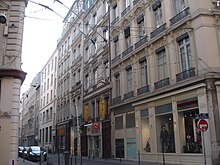 | |
| Type | Street |
|---|---|
| Location | 1st arrondissement of Lyon, Lyon, France |
| Postal code | 69001 |
| Coordinates | 45°45′58″N 4°50′11″E / 45.76612°N 4.836431°E / 45.76612; 4.836431 |
The Rue de l'Arbre-Sec (French pronunciation: [ʁy də laʁbʁ sɛk]) is an old street located in the 1st arrondissement of Lyon, near the Place des Terreaux and the Opera Nouvel. It starts perpendicular to the rue Édouard-Herriot and ends with the Quai Jean Moulin crossing the rue de la République. The name dates from the 14th century and was probably chosen because of a dry tree that could be seen in this street and of an inn sign.
History
The 1745 almanac of Lyon justified the name of the street stating that a stunted tree which was very dry could be seen at one end of the street.
In 1518, a plan for drainage, grading and crossing of the street was decided by Jean de Paris. In the nineteenth century, the zone between the Rue Garet and the Rhône was named Rue Basseville in which there were six silk workshops; it became part of the rue de l'Arbre-Sec in 1855.
The street was already on a plan of 1550 and was inhabited almost exclusively by silk workers, potters and tile makers (in 1828, there were twelve silk workshops and 43 houses). When he restructured the quarter, prefect Claude-Marius Vaïsse decided to demolish some old buildings to build the rue de l'Hôtel de Ville and the rue de la République. On 25 June 1778, cobbler Durant, who lived in the street, was convicted of illegally practicing medicine.
In 1831, a lot of umbrellas with handle containing a triangular dagger were discovered at No. 14.
In 1844, there was the Hôtel de France at No.13. In 1847, a chapel in the street was then the only evangelical place of worship in Lyon at the time. Among the famous residents of the street, there were the family of Louise Labé, painter Salomon Bernard (16th century), and architects Barthélémy Vignon and Prosper Mourand (19th century).
Architecture
The street is slightly curved. It is first wide and lined with buildings of about 1870 with wrought iron balconies and decorations. Further, the SocGen has also wrought iron arches. After the rue Garet, the street is narrower and older, with simple facades and stone arches. The street name is engraved in stone of the last building that is fairly recent, at number 20. The iron balcony at No. 8 dates from 1863. The houses at No. 10 and 12 have arcades, and the No. 22 displays the inscription "Le Thuilerie, 1702".
There are many restaurants and bouchons, including Le Petit Damier and Le Connétable.
There is a straight blocked up traboule at No. 8 which starts with a building of 1863 and includes a path with edge vault.
Photos
-
 The corner of the street with the rue Édouard-Herriot
The corner of the street with the rue Édouard-Herriot
-
Building door of the 20th century
-
Building door
-
View on the Rhône side
-
A Madonna and Child
-
Plaque of the street
References
- "Les noms de rues ou de places liés à une enseigne" (PDF) (in French). Lyon. Archived from the original (PDF) on 18 July 2011. Retrieved 12 December 2009.
- Champdor, Albert (1974). Vieilles chroniques de Lyon (in French). Vol. 8. p. 89.
- Brun De La Valette, Robert (1969). Lyon et ses rues (in French). Paris: Le Fleuve. p. 118.
- Vanario, Maurice (2002). Rues de Lyon à travers les siècles (in French). Lyon: ELAH. p. 16. ISBN 2-84147-126-8.
- Vincent, Marcel (1994). Ozanam: une jeunesse romantique, 1813-1833 (in French). p. 32. ISBN 2-7122-0515-4. Retrieved 1 June 2010.
- ^ Maynard, Louis (1932). Dictionnaire des lyonnaiseries — Les hommes. Le sol. Les rues. Histoires et légendes (in French). Vol. 1 (1982 ed.). Lyon: Jean Honoré. pp. 70–72.
- Bouchard, Gilbert (2000). L'histoire des rues de Lyon (in French). Grenoble: Glénat. p. 8. ISBN 2-7234-3442-7.
- Girault De Saint Fargeau (1844). Guide pittoresque portatif et complet du voyageur en France (in French). Paris: Firmin Didot. p. 448.
- Fisch, Georges (1854). Le méthodisme à Lyon, d'après le rapport du pasteur Fisch. Récits et assertions rectifiés par un ancien vicaire général (in French). Lyon: Gérard & Josserand. pp. 25–26. Retrieved 1 June 2010.
- Vachet, Adolphe (1902). À travers les rues de Lyon (in French) (1982, Marseille ed.). Lyon: Laffitte reprints. pp. 38–39. ISBN 2-7348-0062-4.
- Pelletier, Jean (1986). Lyon pas à pas — son histoire à travers ses rues — Presqu'île, rive gauche du Rhône, quais et ponts du Rhône (in French). Roanne / Le Coteau: Horvath. p. 19. ISBN 2-7171-0453-4.
- "Rue de l'Arbre-Sec" (in French). Rues de Lyon. Retrieved 12 December 2009.
- Maynard, Louis (2009). Histoires, légendes et anecdotes à propos des rues de Lyon, avec indication de ce qu'on peut y remarquer en les parcourant (in French). Les Traboules. p. 26. ISBN 978-2-911491-57-3.
- Labourdette, Jean-Paul; Auzias, Dominique; Serex, Anthony; Bonamy, Matthieu (2009). Le Petit Futé Lyon (in French). p. 146. Retrieved 1 June 2010.
- Dejean, René (1988). Traboules de Lyon — Histoire secrète d'une ville (in French). Le Progrès. p. 109. ISBN 2-904899-01-4.